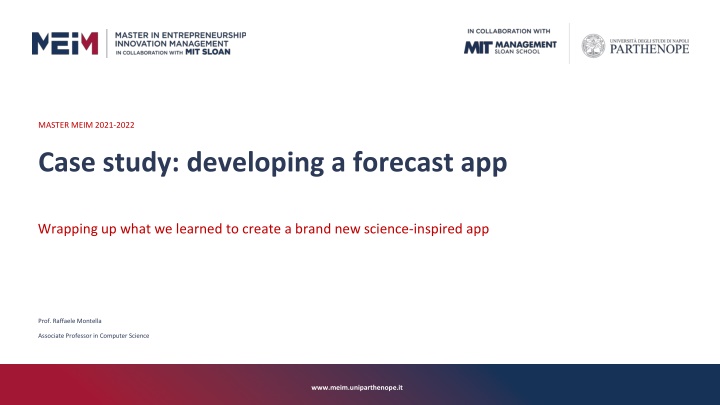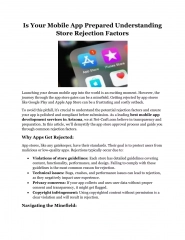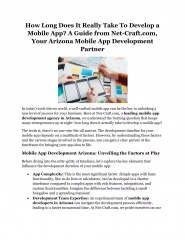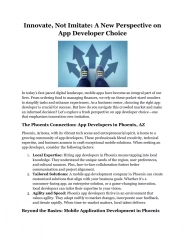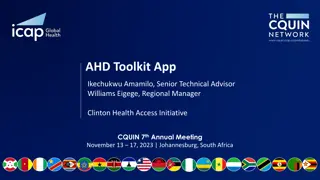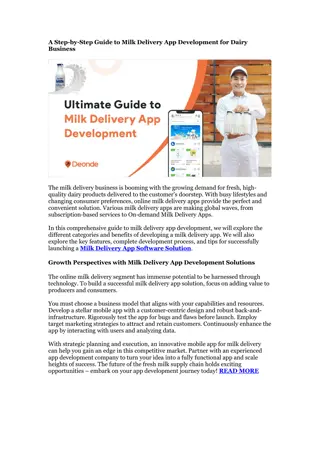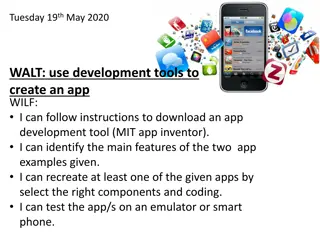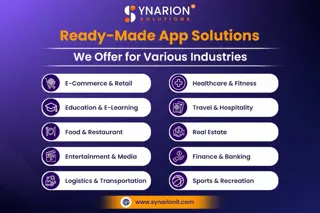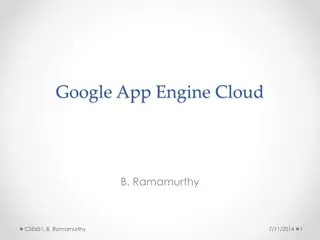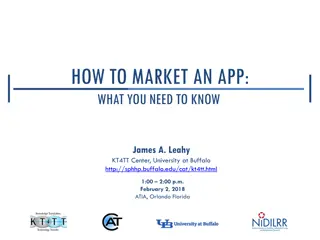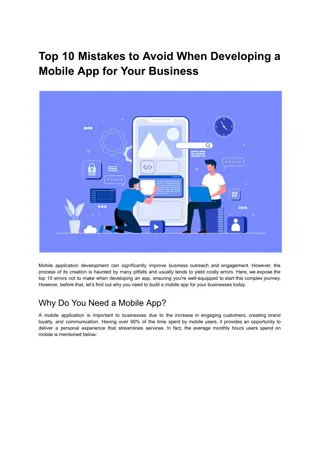Case study: developing a forecast app
Web and mobile computing have revolutionized the way applications are developed and used. This case study explores the shift towards progressive web apps, detailing the advantages of native mobile applications and the concept of UX-Convergence. Learn about the principles of service workers and how they contribute to the responsive behavior of apps. Dive into the world of hybrid methodologies and the adaptability of progressive web apps across various devices.
Uploaded on Feb 17, 2025 | 2 Views
Download Presentation

Please find below an Image/Link to download the presentation.
The content on the website is provided AS IS for your information and personal use only. It may not be sold, licensed, or shared on other websites without obtaining consent from the author.If you encounter any issues during the download, it is possible that the publisher has removed the file from their server.
You are allowed to download the files provided on this website for personal or commercial use, subject to the condition that they are used lawfully. All files are the property of their respective owners.
The content on the website is provided AS IS for your information and personal use only. It may not be sold, licensed, or shared on other websites without obtaining consent from the author.
E N D
Presentation Transcript
MASTER MEIM 2021-2022 Case study: developing a forecast app Wrapping up what we learned to create a brand new science-inspired app Prof. Raffaele Montella Associate Professor in Computer Science www.meim.uniparthenope.it
Outline Introduction Web Technologies and Mobile Computing Progressive Web App Service Worker Manifest Hello World Conclusions Outline
Introduction Web and mobile computing are two intimately connected technologies. Currently 85% of mobile users use smart client applications, 15% microbrowser applications. A smartphone user spends 80% of their time interacting with only 3 of the installed applications. Most smart client applications are nothing more than highly specialized browsers. Introduction
Introduction Only 20% of the applications in the stores are written with native Android / iOS SDKs. 80% of published applications are developed with a hybrid methodology. The application is written using techniques of web technologies. Then it is "embedded" in a native code runtime. This applications behave like native applications. Introduction
Introduction Advantages of native mobile applications: They can take full advantage of the features of the device. They can work even in the absence of a network. They can be published (and sold on the stores) Disadvantages: Long publishing and updating times. Store policies must be adhered to. Managing the codebase for applications for different devices can be expensive. Introduction
Progressive Web App It is designed to work on any browser that supports it, progressively increasing its functionality according to the device used. It is developed in such a way that it adapts to any form factor of the displays used: desktops / laptops, tablets, smartphones, smart-TVs and more in the future. It is connection independent as it must be developed to be available even in the absence of a network or when the network is of poor quality. Progressive Web App
Progressive Web App The user interface and its user experience is such that it is similar to an app in all by applying the principle of UX-Convergence. UX-Convergence: User interface common to different systems of use in order to increase the "recycling of knowledge" by users. It is one of the levers for limiting the digital divide. Thanks to a component that works in the background, it has a responsive behavior in terms of data availability (service worker). Progressive Web App
Progressive Web App They are secure as they must be served over HTTPS 2. They have a manifest file that collects the main information and configuration in order to be found and cataloged by search engines. Intensive use of push notifications to ensure the involvement of users who do not have to visit the application to be updated. Users can install such an application on their desktop as part of a native app. Progressive Web App
User Interface and User Experience PWAs must be able to be downloaded immediately, even if the server on which they are published is down or the network connection is of poor quality. It must respond quickly, if present, the animations must be harmonious and fast, above all they must work in full screen without having to request the scroll of the page. They must not be dissimilar to a native app and share the U-X with them. User Interface and User Experience
The app store is not necessary PWAs are installable on users' home screens. It is not necessary to download them from a store. Advantages: Quick deployment, no policies required. Always up to date, it's not changing software on your device. Disadvantages: It is not possible to "sell" applications. The applications are not currently collected in "stores" or catalogs. The app store is not necessary
Always available: service worker It is a client side proxy that allows to intercept all HTTP requests made by the application. Allows to have complete control over the cache. Resources are identified according to a key/value scheme. The cache is managed automatically by the browser, but it is possible to customize the response to requests. The pre-caching of resources allows to mitigate the absence of the network. Always available: the service worker
Always available: service worker The customized use of the cache can allow advanced processing. Example: A weather application must show forecasts in relation to the user's geographical position. The application makes an HTTP Request to check if there are updated forecasts. If they are available, download them. If the network is available, the application downloads the data for 72 hours of forecast. At the next request, even if the network is not present, the forecasts will be available. Always available: the service worker
Always available: service worker Web Browser (full screen) The Internet Smart TV Service Worker Web Server Tablet Smart Phone Application Provider Data Provider Desktop Cache When the application is launched via icon, the service worker allows the progressive web app to load instantly regardless of the network status. Always available: the service worker
Always available: service worker This prevents the user from abandoning the application if the loading is too slow. 53% of users abandon an application or a web portal if they are not responsive within 3 seconds. Always available: the service worker
Always available: service worker The service worker runs in the background from the browser regardless of the application. It is a javascript file that does NOT have direct access to the Document Object Model. It can communicate with the pages it controls by replying to messages sent through postMessage. Always available: the service worker
Always available: service worker Register The pages, if necessary, can intervene on the DOM. The service worker is a programmable network proxy that allows to control how pages are loaded. Install Error Activated Lifecycle. Idle Terminated Active Always available: the service worker
The application manifest PWAs offer a full screen U-X type. They can use push notification. The manifest is a json file that collects the application settings. The manifest allows to specify how the application should be launched. Allows to specify the icon, the orientation of the screen, hide or display the browser window The application manifest
Lighthouse It is an open source automatic tool for improving the quality of web pages. You can check any page, even public, even if it requires authentication. It has the possibility to have it tested on: Performance Accessibility Progressive Web App Other... Lighthouse
PWA Hello World Make sure you have Google Chrome installed. Use any IDE that has a local web server for testing web applications. It is suggested to use WebStorm (https://www.jetbrains.com/webstorm/) Create a new empty project by calling it pwa01 PWA Hello World
PWA Hello World Create the following directories: css js Images Create the index.html file Create the css/style.css file PWA Hello World
PWA Hello World: index.html <!doctype html> <html lang="en"> <head> <meta charset="utf-8"> <title>Hello World</title> <link rel="stylesheet" href="css/style.css"> <meta name="viewport" content="width=device-width, initial-scale=1.0"> </head> <body class="fullscreen"> <div class="container"> <h1 class="title">Hello World!</h1> </div> </body> </html> PWA Hello World: index.html
PWA Hello World: css/style.css (1/2) body { font-family: sans-serif; } /* Make content area fill the entire browser window */ html, .fullscreen { display: flex; height: 100%; margin: 0; padding: 0; width: 100%; } PWA Hello World: css/style.css (1/2)
PWA Hello World: css/style.css (2/2) /* Center the content in the browser window */ .container { margin: auto; text-align: center; } .title { font-size: 3rem; } PWA Hello World: css/style.css (2/2)
PWA Hello World From the editor window of the index.html file, launch the Chrome browser. Activate Lighthouse by pressing the F12 key. Select the Audits option. Select only "Progressive Web App" and click on Generate Report. PWA Hello World
PWA Hello World The application is not optimized as a PWA. We create the file that implements the service worker and the calling program of the application. File: sw.js js / main.js PWA Hello World
PWA Hello World: sw.js (1/2) let cacheName = 'pwa01'; let filesToCache = [ 'index.html', 'css/style.css', 'js/main.js' ]; /* Start the service worker and cache all of the app's content */ self.addEventListener('install', function(e) { e.waitUntil( caches.open(cacheName).then(function(cache) { return cache.addAll(filesToCache); }) ); }); PWA Hello World: sw.js (1/2)
PWA Hello World: sw.js (2/2) /* Serve cached content when offline */ self.addEventListener('fetch', function(e) { e.respondWith( caches.match(e.request).then(function(response) { return response || fetch(e.request); }) ); }); PWA Hello World: sw.js (2/2)
PWA Hello World: js/main.js (1/2) window.onload = () => { 'use strict'; if ('serviceWorker' in navigator) { navigator.serviceWorker .register('./sw.js').then(function (registration) { // Service worker registered correctly. console.log('ServiceWorker registration successful with scope: ', registration.scope); }, PWA Hello World: js/main.js (1/2)
PWA Hello World: js/main.js (2/2) function (err) { // Troubles in registering the service worker. :( console.log('ServiceWorker registration failed: ', err); }); } } PWA Hello World: js/main.js (2/2)
PWA Hello World Add the following line in the index.html file just before closing the </body> tag: <script src = "js / main.js"> </script> Run the test again via Lighthouse. The service worker now allows to load the page when you are offline. PWA Hello World
PWA Hello World: manifest.json You need to create the manifest.json file in the project root: { "name": "Hello World", "short_name": "Hello", "lang": "en-US", "start_url": "index.html", "display": "standalone", "background_color": "white", "theme_color": "white" } And add the following lines in the header of the index.html file: <link rel="manifest" href="manifest.json"> <meta name="theme-color" content="white"/> PWA Hello World: manifest.json
PWA Hello World Run the test again via Lighthouse. Most of the requirements for a web application to be considered a PWA are met. All that remains is to add the icons. Since different devices have different resolutions it is necessary to create an appropriate set of icons. PWA Hello World
PWA Hello World: icons You need to update the manifest.json file in order to add icons: { Specifies icons for the browser to use when representing the app in different places (such as on the task switcher, or more important, the Home screen). "name": "Hello World", "short_name": "Hello", "lang": "en-US", "start_url": "index.html", "display": "standalone", "background_color": "white", "theme_color": "white", "icons": [ { "src": "icon/icon.png", "sizes": "192x192", "type": "image/png" } ], We've included only one in our demo. } PWA Hello World: icons
PWA Hello World: icons As shown in the manifest listing, we are including a 192 x 192 px icon for use in our app. You can include more sizes if you want; Android will choose the most appropriate size for each different use case. You could also decide to include different types of icons so devices can use the best one they are able to (e.g., Chrome already supports the WebP format). Note that the type member in each icon's object specifies the icon's mimetype, so the browser can quickly read what type the icon is, and then ignore it and move to a different icon if it doesn't support it. PWA Hello World: icons
PWA Hello World: Fetch data from API (1/2) We need to use JQuery. Add the following line in the index.html file just before closing the </body> tag: <script src="https://code.jquery.com/jquery-3.3.1.min.js" integrity="sha256-FgpCb/KJQlLNfOu91ta32o/NMZxltwRo8QtmkMRdAu8=" crossorigin="anonymous"> </script> PWA Hello World: Fetch data from API (1/2)
PWA Hello World: Fetch data from API (2/2) In js/main.js file add following code: $(document).ready(function () { let url = 'http://193.205.230.6/products/wcm3/timeseries/porti116'; $.get(url, function (data) { $.each(data.timeseries, function (key, items) { console.log(items); }) }) }); $(document).ready(function(){}: jquery makes sure the element has been loaded. Set endpoint API (http://193.205.230.6/products/wcm3/timeseries/porti116). Use jquery ajax to make a request to the endpoint, using the $ .get () method. Iterate over items: using $.each() method. console.log(): to see the response of the data. PWA Hello World: Fetch data from API (2/2)
PWA Hello World: Fetch data from API (2/2) window.onload = () => { 'use strict'; if ('serviceWorker' in navigator) { navigator.serviceWorker .register('./sw.js').then(function (registration) { // Service worker registered correctly. console.log('ServiceWorker registration successful with scope: ', registration.scope); }, function (err) { // Troubles in registering the service worker. :( console.log('ServiceWorker registration failed: ', err); }); } $(document).ready(function () { let url = 'http://api.meteo.uniparthenope.it/products/wcm3/timeseries/porti116'; $.get(url, function (data) { $.each(data.timeseries, function (key, items) { if (items["sts"]>=2) { $("#content").append("<img src='icon/sts_"+items["sts"] + ".png'/><br/>"+items["dateTime"]+"<hr/>") } }) }) }); }
Conclusions Progressive Web Apps are a valid alternative to smart client apps. Today they are the standard unless special cases. They don't need to be published on a store. It is not possible to sell them. It is possible to keep a single codebase for different clients. Conclusions
MASTER MEIM 2021-2022 magnificent and progressive www.meim.uniparthenope.it
